


Pieter Bruegel de Oude
ca. 1525 – 1569
Pieter Bruegel de Oude’s date and place of birth cannot be confirmed with certainty. When he was about 20 years old, he was apprenticed to Pieter Coecke van Aelst (1502-1550). He later married van Aelst’s daughter whom he got two sons with who also became famous painters.
Bruegel travelled to Italy, which was a mandatory trip in those days, to study the classical antiquity and the grand Italian masters of that time. After his return he settled in Antwerp where he almost immediately became famous because of his etching, engraving, drawings and landscape paintings.
Pieter Bruegel de Oude preferred to paint folk scenes and scenes from rural life, such as The Peasant Wedding (1567/68) which almost everyone knows from the placemats in the pancake houses. These are atmospheric everyday performances that he portrays with much affinity.
Nevertheless, Bruegel is especially world famous for two works that receive a tribute in REMASTERED. These are The Tower of Babel (1563) which hangs in Museum Boijmans van Beuningen in Rotterdam, and The Triumph of Death (1562).

Pieter Bruegel de Oude, The Tower of Babel, 1563, oil on panel, 59.9 x 74.1 cm. Collection Museum Boijmans van Beuningen, Rotterdam
The biblical story of the Tower of Babel takes place in the land of Sinear where Nimrod is the leader. He orders the tower to be built to fulfil his heart’s desire to be close to God. God condemns this ambition and punishes man by making them all speak a different language. Now it’s hard to understand each other and the construction of the tower slows down endlessly. The story contains a universal message. It is about the pride of mankind who blindly trusts his own abilities and the unlimited possibilities of technology. In the 16th century, the Tower of Babel was a popular theme, especially in Antwerp where Bruegel used to work. Antwerp as a busy port where ships come from all over the world and many languages can be heard in the street.

Pieter Bruegel de Oude, The Triumph of Death, 1562, oil on panel 120 x 160 cm. Collection Prado Museum, Madrid
In the painting The Triumph of Death, the Biblical Judgment Day has arrived. On the left is an army of skeletons that gathers people in a container-like building. On the right you see a cart full of skulls pulled forward by an emaciated horse with a skeleton holding an hourglass in his hand.
Human horrific horrors such as murderousness, demons and fear and dominate the performance. No one is spared from farmer to nobleman, king and cardinal, they all face their deaths.
